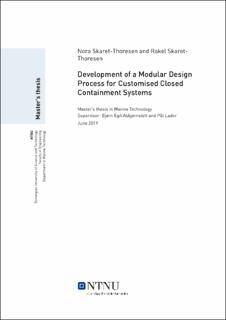| dc.description.abstract | Norge er verdens største produsent av atlantisk laks. Videre vekst er i tillegg ventet da regjeringen har uttalt en visjon om å femdoble produksjonsvolumet innen 2050, sammenlignet med 2010. Vekst kan for øvrig ikke prioriteres for enhver pris, og blant forutsetningene for veksten er at dagens miljø- og sykdomsutfordringer løses og at en lykkes med innovasjon innen teknologi. Det sees mot lukkede anlegg som en potensiell løsning på flere av problemene som eksisterer for åpne, tradisjonelle oppdrettsanlegg. Spesielt når det kommer til de økologiske utfordringene, da oppdretter vil få økt kontroll over påvirkningen det indre miljøet har på omgivelsene når merden er lukket. Sammenliknet med antallet leverandører av tradisjonelle oppdrettsanlegg, er det få leverandører av lukkede sjøanlegg i Norge. Dette, samt den korte tidsperioden produktet har blitt benyttet kommersielt, er trolig årsaken til den begrensede kunnskapen og erfaringen som finnes for prosjektering av produktet. Det overordnede målet for denne oppgaven er å opparbeide bredere kunnskap om masseprodusert skreddersøm av lukkede anlegg, basert på et sett av standardiserte moduler. Oppgaven er forsøkt løst ved en tredelt tilnærming, der forståelse av teknologi, biologi og elementer fra systemanalyse og design står sentralt.
Gjennom utførelse av en grovanalyse er kritiske hendelser samt risikoreduserende tiltak for systemet forsøk kartlagt. Denne kunnskapen bidrar til å øke forståelsen av konstruksjonen og hvordan man gjennom designet kan redusere risikoen for uønskede hendelser. I tillegg ble en rekke funksjoner systemet må opprettholde utarbeidet. Dette innebar blant annet arbeid med å forstå de hydrodynamiske kreftene som virker på konstruksjonen.
Basert på den opparbeidede kunnskapen, er det utviklet et enkelt verktøy som kan foreslå et skreddersydd design av systemet, basert på standardiserte moduler. Produktet er skreddersydd etter informasjon om kundens produksjonsplan, informasjon fra lokalitetsanalysen og ytterligere kundevalg. Modulbaserte produkter assosieres gjerne med reduserte kostnader og tidsbruk i designfasen. Det lukkede anlegget vil også dra nytte av disse fordelene, da design og sertifisering av de standardiserte komponentene kun må gjøres en gang. Flytekragen er et eksempel på en slik modul. Videre er en fordel med det modulbaserte designet at effektiviteten i designfasen vil øke, og forventet risiko vil minke da sjansen for å oppdage feil er større for velutprøvde produkter. Designet tilrettelegger også for utskiftingsmuligheter på et senere stadium i produktets livsløp. Dette er gunstig, da arbeidet med å revidere NS 9415:2009 er i gang, og forandringer på eksisterende design kan bli nødvendig grunnet endringer i regelverket. Noen ulemper knyttet til det modulære design er redusert fleksibilitet, tap av markedsorientering og økt strukturelt volum og vekt. | |
| dc.description.abstract | Norway is presently the world's biggest producer of Atlantic salmon. Still, further growth is expected as the government has stated a goal of multiplying the production volume by five within 2050, baseline being 2010. The industry is facing several challenges related to traditional technology, and there are concerns related to escapes, pollution, sea-lice and diseases. To circumvent these shortcomings closed containment systems is a viable solution as the farmer has increased control of the interaction between the farmed fish and the environment. However, compared to the number of market players supplying traditional fish farms, few manufacturers supply closed containment systems. This fact, combined with the short time period the product has been commercially utilized, leaves limited knowledge and experience regarding the design process for these solutions. The overall objective of this thesis is to develop inside knowledge for design of customized closed containment systems, based on standardised modules. This work requires a threefold approach, including a technical aspect, a biological aspect and elements from system analysis and design.
The construction must be designed to be able to withstand the loads to which they are exposed at site, and at the same time facilitate good growth conditions. Through implementing a Preliminary Hazard Analysis, this paper maps hazardous events for closed containment systems along with related risk reducing measures. This knowledge contributes to increasing the understanding of how to design a safe system. In addition, functions that the systems must facilitate have been established. An important aspect of this work is to study the metocean effects from waves and current, acting on the construction. Based on the obtained knowledge, a simple tool that proposes an appropriate design for the customised closed containment systems is developed. The design is customised based on information from the production plan, site survey and additional customer wishes. This final design is assembled by 18 modules, of which eleven are standard in all deliveries and the remaining seven are customized for each delivery.
The modular product has the benefit of reduced design time and cost. Among other factors, this is because the design of standardised components only needs to be done once, and that certificates for main components like the floating collar are already available. The production efficiency is likely to increase, and the expected risk will decrease as it results in a higher chance of eliminating potential failures. The modularised closed containment system also facilitates exchange possibilities. It is decided to facilitate changes in design, for example if required by new laws and regulations like the revision of NS 9415:2009 will lead to. There are however some drawbacks of modularisation such as loss of flexibility, market orientation and increased structural volume and weight.
It is concluded that valuable inside knowledge for the design process is obtained. Based on evaluation of the advantages and drawbacks of the design, it is found that a modular design strategy is beneficial. Performing the case study has shown that the developed design tool is able to propose a customized design, based on information obtained from the customer. The level of detail of the proposed design is however low, and the grounds for decisions made related to the solution spaces are of varying strength. Improvements to the tool are therefore still required if it should be of any use. | |
